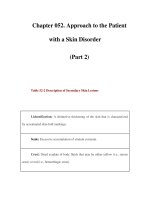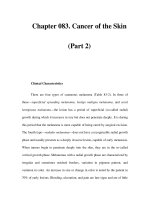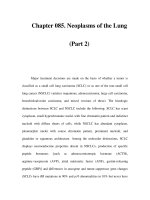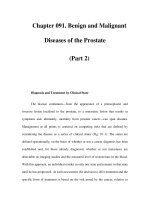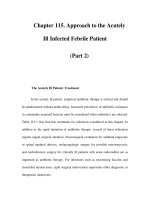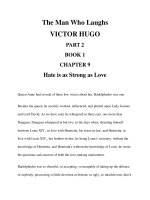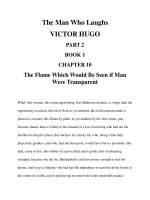Semantics chapter 5
Bạn đang xem bản rút gọn của tài liệu. Xem và tải ngay bản đầy đủ của tài liệu tại đây (235.98 KB, 39 trang )
PART 2 - CHAPTER V
THE MEANING OF THE SENTENCE
CHAPTER OUTLINE
5.1 Introduction
5.2 Grammaticality, acceptability and meaningfulness
5.3 The principle of compositionality
5.4 Variables in the function of sentence meaning
5.5 The representational meaning
5.6 The interpersonal meaning
5.1 INTRODUCTION
THEORIES CONCERNING THE MEANING OF THE SENTENCE
1.
2.
3.
4.
The denotational theory / correspondence theory of meaning
The conceptualist theory
The pragmatic theory / meaning-in-use theory
The cognitive theory
1.
The denotational theory / correspondence theory of meaning
The meaning of an expression is characterized in terms of the
notions reference and truth
The meaning of a sentence can be described by specifying when it is
true.
The correspondence between language and the world is the crucial
element of meaning.
2.
The conceptualist theory
The meaning of an expression is identified with the concepts or
ideas associated with the expression or with a mental representation
of the content of the expression, often making use of decomposition
of meaning.
3.
The pragmatic theory / meaning-in-use theory
The meaning of an expression is identified with the use that is
made of it by participants in an interaction.
4.
The cognitive theory
The meaning of an expression is identified as a reflection of
the way we conceptualize the world out there.
The meaning of a sentence / utterance will reflect our
experience of the world, and is the combination of its parts.
5.2. GRAMMATICALITY, ACCEPTABILITY AND MEANINGFULNESS
These three concepts are interrelated and should not be confused.
Grammatical sentences are not necessarily meaningful or acceptable.
The farmer has killed the house.
Grammatical, meaningless, unacceptable
Fully grammatical and perhaps meaningful sentences are, for a
variety of reasons, unacceptable (the reason may be a taboo / social
etiquette in certain English-speaking society)
His father died last night.
Grammatical, meaningful, acceptable
My father died last night.
Grammatical, meaningful, unacceptable
Acceptability may have to do with what is called rationality and
logical coherence.
He thought that it was possible because it was not impossible .
Grammatical, but nonsense
There are many sentences whose unacceptability is quite definitely a matter of
grammar rather than semantics.
I want that my daughter marry him.
meaningful, but ungrammatical and unacceptable
The meaningfulness of a sentence is conditioned by semantics in spite of how
well-formed that sentence is.
a.
Colourless green ideas sleep furiously. (N. Chomsky)
Quadruplicity drinks procrastination. (B. Russell)
Thursday is in bed with Friday. (G. Ryle)
b.
c.
5.3. THE PRINCIPLE OF COMPOSITIONALITY
(syntax – semantics interface)
The meaning of a sentence is determined by the meanings of its parts
(semantics) and by the way in which those parts are assembled (syntax).
This compositional approach will have two aspects:
An account of the meanings of the basic elements of languages (words and
morphemes)
An account of how the meanings of complex expressions (phrases and
sentences) are built up from the meanings of their parts.
1.
2.
The meaning of the sentence The little boy kicked the ball consists of the
meanings of the following phrases:
- NP: the little boy
- VP: kicked the ball (which in turns consists of the meaning of the verb kick
and that of the ball
At least, the meanings of the three head words of these phrases: boy, kicked,
ball determine that of the sentence.
At the phrase level, each NP (the little boy, the ball) will have its meaning
derived from the head noun, determiner “the” and the modifying adjective
(little) meanings.
In every language, in every communication this principle is the most common
one to be followed by speakers of the language community.
Apart from this, there may be others: non-compositionality (ie. uses of
transference of meanings – metaphor, metonymy, idioms, proverbs) and other
factors which may be attached to specific cases dominated by cultural features
of the language as well.
5.4. VARIABLES IN THE FUNCTION OF SENTENCE MEANING
On the basis of the principle of compositionality, it is possible to speak about a
number of meanings that reside in the sentence: structural, textual,
representational and interpersonal.
Structural meaning:
- The structural meaning of the sentence is the kind of meaning that results from a
particular arrangement of the parts of the sentence.
The mantte wernnted a yob.
Our knowledge of English is sufficient to allow us to understand that this
sentence is about something that did something to something else.
Representational meaning:
The representational meaning may be defined in terms of
experiential and logical functions (meanings).
- The experiential function is to communicate ideas. It is the main
function by which a speaker expresses the content elements of his
utterance, by referring to people, objects, states of affairs, events,
qualities, places, actions and circumstances.
Bill Gates gave me books to read after each session .
It is possible to understand the experiential meaning of this sentence as
it contains speaker, actions (give, read), past – gave, object – books,
actor – Bill Gates, time – after each session, and recipient – me.
- The logical function relates ideas to each other on an equal or
subordinate basis.
I came, I saw and I conquered. (equality or co-ordination)
I came early so that I could meet her. (subordination)
Interpersonal meaning:
The interpersonal function of language is firstly to:
- establish and maintain social relations (phatic function - used to share
feelings or to establish a mood of sociability rather than to
communicate information or ideas.)
Good morning / Have a nice day.
- influence people’s behaviour and get things done (instrumental function).
Can you get me some water, please?
Danger. Road works.
- express the speaker’s feelings, attitudes and opinions.
What she said might be right.
You must be feeling hungry.
Textual function:
- The textual function is to create texts. It is this function which helps to
give texts coherence and cohesion.
5.5. THE REPRESENTATIONAL MEANING
According to Halliday, the experiential subcomponent of the representational meaning
provides an account of the underlying content. As such it handles within its scope all types
of processes, qualities, participating entities (or arguments / participants) and
circumstances.
Processes
actions, events, states, relations
Participating entities
persons, objects and abstractions
Circumstances
time, place, manner, reasons, conditions,
concession, results
She kicked the dog out of the house.
1. The process:
Process is a powerful concept which represents the possible worlds as
consisting of goings-on: of doing, happening, feeling and being.
Process can be classified into:
(i) Material processes
(ii) Mental processes
(iii) Relational processes
(iv) Behavioral processes
(v) Verbal processes
(vi) Existential processes
(i) Material processes – processes of doing.
- A material process usually involves an actor and a goal.
E.g. She
hit
the ball.
actor
material process
goal


